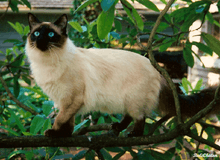Allergy to cats
Allergies to cats are one of the most common allergies among individuals, resulting in 99.7 and 99.9% of households in the United States that are affected by responsible allergens.[1] Among the eight known cat allergens, the most prominent allergen is secretoglobin Fel d 1, and it is produced in the anal glands, salivary glands, and, mainly, in sebaceous glands of cats. Allergic symptoms associated with cats include coughing, wheezing, chest tightening, itching, nasal congestion, rash, watering eyes, sneezing, chapped lips, and similar symptoms. In worst case scenarios, allergies to cats can develop into more life-threatening conditions such as rhinitis and mild to severe forms of asthma.[1] Despite these symptoms, there are many types of solutions to mitigate the allergic effects of cats, including medications, vaccines, and home remedies. Hypoallergenic cats are another solution for individuals who want to pets without the allergic consequences. Furthermore, prospective pet owners can reduce allergic reactions by selecting cats of a specific gender or color, which are associated with a lower production of allergens.
Cat allergens

Eight cat allergens have been recognized by the World Health Organization/International Union of Immunological Societies (WHO/IUIS) Allergen Nomenclature Sub‐Committee. Fel d 1 is the most prominent cat allergen, accounting for 96% of human cat allergies.[2] The remaining cat allergens are Fel d 2-8, with Fel d 4, an urinary protein, occurring the most in humans among the other seven allergens. All cats produce Fel d 1 including hypoallergenic cats. The main way these allergens are spread is through a cat’s saliva or dander, which gets stuck on clothing. A study found that 63% of people allergic to cats have antibodies against Fel d 4.[3]
Fel d 1
Fel d 1 is the most dominant cat allergen. It is part of the secretoglobulin family, which are proteins found only in mammals. Fel d 1 is primarily secreted through the sebaceous glands and can be found on the skin and fur of a cat. It is less commonly secreted through the salivary gland, lacrimal glands, skin and anal glands.[4]
Fel d 4 and Fel d 7
Fel d 4 and Fel d 7 are cat lipocalins. Fel d 4 and Fel d 7 are one of the most common cat allergens after Fel d 1. Fel d 4 is primarily found in cats' saliva and is associated with atopic dermatitis in children with cat allergies.[4]
Symptoms
.jpg)
Symptoms of an allergic reaction to cats range from mild to severe, and include swollen, red, itchy, and watery eyes; nasal congestion, itchy nose, sneezing, chronic sore throat or itchy throat, coughing, wheezing, asthma, hay fever,[5] hives or rash on the face or chest, or itchy skin. If a cat has scratched, licked, or bitten someone who is allergic to cats, redness and sometimes even swelling of the affected area will occur. For those severely allergic, a reaction may resemble that of someone with a severe food allergy, and such reactions require emergency medical care.[6][7]
Body’s response to the allergen
As the allergen enters through the nose or mouth, antigen cells analyze the allergen and present antigenic peptides to helper T cells.[2] The helper T cells acquire a type 2 phenotype (Th2) and produce IgE due the presence of specific cytokines. If Th2 is expressed too much, the symptoms of cat allergies appear. Inhaled cat allergens will activate mast cells, causing coughing, increased mucous production, and airway constriction.
Coping with allergies
Lower exposure
Allergens that are airborne survive for months or even years by themselves, hence removing anything that can trap and hold the allergens (carpet, rugs, pillows) and cleaning regularly and thoroughly with HEPA filters and electrostatic air purifier systems reduces risk. Frequent hand washing, especially after handling the cat, and washing hands prior to touching eyes, nose, or mouth, and limiting the cat's access to certain rooms, such as the bedroom or other rooms where much time is spent, may also reduce allergic reactions.
Medications
Cat allergies can often be controlled with over the counter or prescription medications. Antihistamines and decongestants may provide allergy relief.[8]
Allergy shots
Some allergy sufferers find relief in allergen immunotherapy, a periodic injection therapy designed to suppress the body's natural immune responses to the cat allergens.[9][10] In its early stages, AIT utilized cat dander extract, which consists of microscopic dry skin flakes of cats, but later resorted to Fel d 1 due to issues of standardization. One way researchers use Fel 1 d in immunotherapy is through the alteration of its chemical structure. Disulfide bonds between Fel d 1 chains were broken to reduce the binding between the allergen and immunoglobulin E (IgE), inhibiting an allergic response.[1] A second method utilizes synthetic epitope vaccines, an in-development vaccine to provide a long-term vaccine for allergies.[11] This method selects Fel d 1 peptides containing T-cell epitopes to produce a vaccine called Allervax CAT. These peptides induce allergic symptoms in less than 1 % of individuals allergic to cats, and, by using this vaccine, the body’s response to Fel d 1 epitopes is diminished.[1]
Cat bathing
Regularly bathing the cat may remove significant amounts of allergens from the fur.[12] After bathing, the levels of Fel d 1 on cat skin and fur return within two days of bathing. In addition, amounts of Fel d 1 in the surrounding air return after a 24 hour period of bathing the cat.[1] Feeding the cat a high quality diet with plenty of omega-3 fatty acids will help keep the coat healthy and minimize dander.[6]
Hypoallergenic cats
A hypoallergenic cat is a cat that is less likely to provoke an allergic reaction in humans. Although the topic is controversial, owners' experience and recent clinical studies suggest that Siberian cats, Devon Rex and Cornish Rex cats, Abyssinian cats, Balinese cats, and several other breeds, especially females, are likely to have low levels of Fel d 1, the main allergenic protein.[13]

From among the above cats noted, the most popular cat breeds to be renowned for their hypoallergenic quality are the Siberian and Balinese. These cats produce much fewer protein allergens in comparison to regular domestic household cats or other cat breeds. Cats that have some Balinese ancestry might produce lower amounts protein allergens. Cat breeds that often have some Balinese lineage include the Oriental shorthair, Oriental longhair, and some Siamese cats.
The common theory among these two hypoallergenic medium- to long-haired cat breeds is that their long-haired gene is associated with producing reduced amounts of allergens. This may be the case as the Balinese cat, a medium to long-haired cat breed (also referred to as the Long-haired Siamese cat) is regarded as hypoallergenic, whereas the Siamese cat, a short-haired breed, is not. Some Siamese cats might possess hypoallergenic qualities if they have Balinese ancestry. This might provide some evidence that the long-haired genes or traits within this cat breed have resulted in a cat that can genetically produce less amounts of the cat allergens.
In 2006, the Allerca company announced the successful breeding of a line of hypoallergenic cats. However, no peer-reviewed studies have been done to confirm their claims and many scientists and consumers are skeptical of the company's assertions.[14] The company has announced that on January 1, 2010 they will cease their breeding activities.[15]
Another company, Felix Pets, also claims to be developing a breed of hypoallergenic cat.[16]
Cat sex and color
Female cats produce a lower level of allergens than males, and neutered males produce a lower level of allergens than unneutered males.[17] In 2000, researchers at the Long Island College Hospital found that cat owners with dark-colored cats were more likely to report allergy symptoms than those with light-colored cats.[18][19] A later study by the Wellington Asthma Research Group found that fur color had no effect on how much allergen a cat produced.[20][21]
See also
References
- Bonnet B, Messaoudi K, Jacomet F, Michaud E, Fauquert JL, Caillaud D, Evrard B (2018-04-10). "An update on molecular cat allergens: Fel d 1 and what else? Chapter 1: Fel d 1, the major cat allergen". Allergy, Asthma, and Clinical Immunology. 14: 14. doi:10.1186/s13223-018-0239-8. PMC 5891966. PMID 29643919.
- Satyaraj E, Wedner HJ, Bousquet J (October 2019). "Keep the cat, change the care pathway: A transformational approach to managing Fel d 1, the major cat allergen". Allergy. 74 Suppl 107 (S107): 5–17. doi:10.1111/all.14013. PMID 31498459.
- Smith W, Butler AJ, Hazell LA, Chapman MD, Pomés A, Nickels DG, Thomas WR (November 2004). "Fel d 4, a cat lipocalin allergen". Clinical and Experimental Allergy. 34 (11): 1732–8. doi:10.1111/j.1365-2222.2004.02090.x. PMID 15544598.
- Chan SK, Leung DY (March 2018). "Dog and Cat Allergies: Current State of Diagnostic Approaches and Challenges". Allergy, Asthma & Immunology Research. 10 (2): 97–105. doi:10.4168/aair.2018.10.2.97. PMC 5809771. PMID 29411550.
- "Allergy to pets and animals". allergyclinic.co.uk. Archived from the original on 2012-01-02. Retrieved 9 November 2011.
- "WebMD - Cat Allergies". WebMD, LLC. Retrieved 9 November 2011.
- "Human Allergies to Cats". Foster & Smith, Inc. Retrieved 9 November 2011.
- Cat Allergies, WebMD, http://www.webmd.com/allergies/cat-allergies
- Varney VA, Edwards J, Tabbah K, Brewster H, Mavroleon G, Frew AJ (August 1997). "Clinical efficacy of specific immunotherapy to cat dander: a double-blind placebo-controlled trial". Clinical and Experimental Allergy. 27 (8): 860–7. doi:10.1046/j.1365-2222.1997.1220903.x. PMID 9291281.
- Hedlin G, Graff-Lonnevig V, Heilborn H, Lilja G, Norrlind K, Pegelow K, et al. (May 1991). "Immunotherapy with cat- and dog-dander extracts. V. Effects of 3 years of treatment". The Journal of Allergy and Clinical Immunology. 87 (5): 955–64. doi:10.1016/0091-6749(91)90417-m. PMID 2026846.
- Larché M, Akdis CA, Valenta R (October 2006). "Immunological mechanisms of allergen-specific immunotherapy". Nature Reviews. Immunology. 6 (10): 761–71. doi:10.1038/nri1934. PMID 16998509.
- Avner DB, Perzanowski MS, Platts-Mills TA, Woodfolk JA (September 1997). "Evaluation of different techniques for washing cats: quantitation of allergen removed from the cat and the effect on airborne Fel d 1". The Journal of Allergy and Clinical Immunology. 100 (3): 307–12. doi:10.1016/s0091-6749(97)70242-2. PMID 9314341.
- "Archived copy". Archived from the original on 2011-07-16. Retrieved 2011-05-10.CS1 maint: archived copy as title (link)
- Felis Enigmaticus
- "Lifestyle Pets". Allerca. Archived from the original on 2009-11-01. Retrieved 2009-11-01.
- Pepling, Racheal. (9 June 2006)."Hypoallergenic" Cats For Sale, U.S. Firm Announces. National Geographic News. Accessed 13 March 2010.
- Jalil-Colome J, de Andrade AD, Birnbaum J, Casanova D, Mège JL, Lanteaume A, Charpin D, Vervloet D (July 1996). "Sex difference in Fel d 1 allergen production". The Journal of Allergy and Clinical Immunology. 98 (1): 165–8. doi:10.1016/s0091-6749(96)70238-5. PMID 8765830.
- full study, cited in the Journal of the American Medical Association
- Hussain S, Bassett C, Kaplan S, Schneider A, Silverman B (January 2000). "Correlation between the color of cat hair and severity of allergic symptoms in patients with allergic rhinitis". J. Allergy Clin. Immunol. 105 (1 Part 2): S5. doi:10.1016/s0091-6749(00)90443-3.
- "cited by Allergy New Zealand". Archived from the original on 2006-09-25. Retrieved 2007-03-20.
- Siebers R, Healy B, Holt S, Peters S, Crane J, Fitzharris P (October 2001). "Fel d 1 levels in domestic living rooms are not related to cat color or hair length". The Journal of Allergy and Clinical Immunology. 108 (4): 652–3. doi:10.1067/mai.2001.118788. PMID 11590399.
External links
- Hecht J (9 June 2009). "Allergen-free cats – a breed apart?". Daily News. New Scientist.
- - Hypoallergenic Cat breed list and information
- Cat Choo - News on immunisation
- Coping with Allergies - Pet Allergy Information